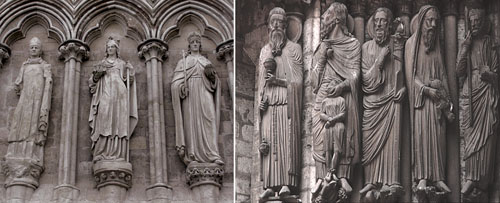Infections of the Earth vs. Statue City
 [Image: Mt. Nemrut stone statue heads].
[Image: Mt. Nemrut stone statue heads].Naturally occuring soil bacteria, called Bacillus pasteurii, could someday "be used to help steady buildings against earthquakes."
These microbes "can literally convert loose, sandy soil into rock."
Through a kind of geological infection, they cause "calcite (calcium carbonate) to be deposited around sand grains, cementing them together," transforming "loose, liquefiable sand into a solid cylinder." This alone could help buildings survive an earthquake.
Interestingly, "similar techniques have been used on a smaller scale, for example, to repair cracks in statues, but not to reinforce soil."
But hearing this reminds me of an article published last year in New Scientist, about "a disease which gradually turns people into living statues." Officially known as sporadic fibrodysplasia ossificans progressiva, it's "a disease in which muscle gradually turns into bone."
According to Wikipedia, this "mutation of the body's repair mechanism causes fibrous tissue (including muscle, tendon, and ligament) to be ossified (turned to bone) when damaged. In many cases they can cause joints to become permanently frozen in place. The growths cannot be removed with surgery because such removal causes the body to 'repair' the area of surgery with more bone."
So the idea here would be to give "statue disease" to the Earth itself: wherever the planet is wounded, it turns itself to rock – or bone, as the case may be – saving us from earthquakes.
 But what amazing architectural structures might result if the world was swept by statue disease! The crowds of Paris, frozen hard as rock in an epidemic of Gothic statuary, webbed together in one vast church of bone. All of Rome becomes a sculpture gallery.
But what amazing architectural structures might result if the world was swept by statue disease! The crowds of Paris, frozen hard as rock in an epidemic of Gothic statuary, webbed together in one vast church of bone. All of Rome becomes a sculpture gallery. Discovering that you, too, are infected, you deliberately seek out a crowd of others, wearing hospital gowns, and you join together in a group to form huge gymnastic shapes – knowing that your joints will soon fuse, becoming an artwork that will outlast Manhattan.
Future archaeologists will burst into tears as they scrape away layers of the Gobi Desert, revealing ten million human statues in an abandoned Beijing...





Comments are moderated.
If it's not spam, it will appear here shortly!
Where was the first picture taken? Thanks.
I couldn't find a way to e-mail you directly, despite looking at your Blogger Profile (which offered no e-mail link) (then again, it could be early in the morning).
Thought this news article may be of interest to you:
http://www.guardian.co.uk/international/story/0,,2024764,00.html
right column, below the google ads in the 'more' section
Thanks, impartation; cool story. The email address in my profile is not a direct link.
And I just added the photo info, which I forgot to do. Meanwhile, the bottom image is really two images, each from a Google search for "statue" and "stone" and "church," etc. etc., but I don't remember where they're from. Chartres, I think.
Post a Comment